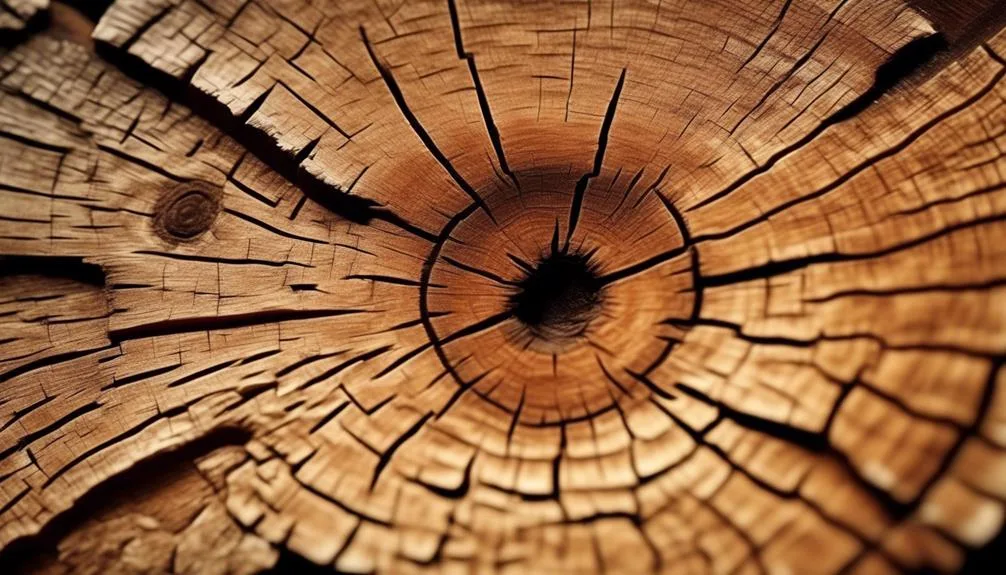Elm wood has long been valued for its resistance to decay, making it a popular choice for furniture, flooring, and outdoor structures.
But just how durable is elm wood, and what factors contribute to its longevity? Understanding the natural properties and influences on its decay resistance can provide valuable insights for those considering using this material.
Let's explore elm wood's remarkable ability to withstand decay without getting overly technical.
Elm Tree Wood Characteristics
Elm tree wood, known for its interlocking grain and resistance to splitting, is highly valued for its durability and strength in various woodworking applications. Its unique properties make it an ideal choice for outdoor furniture, flooring, and shipbuilding.
Elm wood possesses excellent decay resistance, making it suitable for use in moist and damp environments, where other woods may succumb to rot and decay. The interlocking grain of elm wood contributes to its exceptional strength and resistance to warping, ensuring longevity in its applications.
These properties make elm wood an attractive option for projects requiring both durability and a natural aesthetic. When considering decay resistance and overall strength, elm wood stands out as a reliable and versatile choice for woodworking projects.
Factors Affecting Elm Wood Decay
Understanding the environmental and biological factors that contribute to elm wood decay is crucial for preserving its natural durability and strength in woodworking applications.
Factors affecting elm wood decay include environmental conditions, microbial activity, and moisture levels.
Environmental conditions such as temperature, humidity, and exposure to sunlight play a significant role in the decay process.
Microbial activity, including fungi and bacteria, can accelerate the degradation of elm wood.
Moisture levels also greatly impact decay, as excessive moisture provides an ideal environment for decay-causing organisms to thrive.
By carefully managing these factors, such as by using proper treatment and storage methods, you can help prolong the life of elm wood and maintain its quality for various woodworking projects.
Understanding these factors allows for better preservation and utilization of this valuable natural resource.
Natural Resistance to Decay
To enhance the longevity of elm wood and maintain its natural strength, recognizing its inherent resistance to decay is essential in woodworking applications. Elm wood possesses remarkable natural resistance to decay, making it a highly sought-after material for various projects.
Here are some reasons why elm wood's natural resistance is beneficial for you:
- Fungal resistance: Elm wood contains natural compounds that make it highly resistant to fungal decay, ensuring its durability in various environmental conditions.
- Insect damage: Elm wood's natural resistance to insect damage makes it a reliable choice for outdoor furniture and structures, minimizing the risk of deterioration due to insect infestation.
- Long-lasting beauty: The wood's natural resistance allows it to maintain its aesthetic appeal for extended periods, adding value to your woodworking projects.
- Sustainable choice: Elm wood's natural resistance reduces the need for chemical treatments, making it an environmentally friendly option.
Understanding and leveraging elm wood's natural resistance to decay can greatly benefit your woodworking endeavors.
Treatment and Preservation Methods
Consider implementing proven treatment and preservation methods to further enhance the durability and longevity of elm wood in your woodworking projects. Chemical treatments, such as pressure impregnation with preservatives like copper naphthenate or borates, can significantly increase the resistance of elm wood to decay. These treatments create a barrier that prevents decay-causing organisms from thriving in the wood.
Additionally, proper moisture control is essential for preserving elm wood. Ensure that the wood is adequately seasoned and protected from prolonged exposure to moisture to prevent decay. Applying a water-repellent finish can also help minimize moisture absorption.
Summary and Conclusion
Enhancing the durability and longevity of elm wood in your woodworking projects through proven treatment and preservation methods is crucial for ensuring its resistance to decay.
Research findings indicate that while elm wood is naturally resistant to decay, it isn't impervious to it. However, through proper treatment and preservation, its durability can be significantly enhanced.
It's evident that the practical applications of utilizing elm wood in your projects can be maximized by implementing effective preservation techniques. By doing so, you can ensure that your elm wood creations stand the test of time and remain resistant to decay, allowing you to enjoy their beauty and functionality for years to come.
- Preserve the natural beauty of elm wood
- Ensure long-lasting durability in your woodworking projects
- Protect against decay and deterioration
- Maximize the potential of elm wood in your creations
Conclusion
Incorporating elm tree wood into your projects offers natural resistance to decay, making it an ideal choice for outdoor applications. Its inherent durability, coupled with available preservation methods, ensures long-lasting and reliable results.
Consider the possibilities elm wood presents for your woodworking needs and the lasting impact it can have on your outdoor creations.

My interest in trees started when I first saw the giant sequoias in Yosemite.
I was a teenager then, and I remember thinking, “I need to learn more about this.”
That moment stuck with me.
A few years later, I went on to study forestry at Michigan Tech.
Since graduating, I’ve worked in a mix of hands-on tree care and community education.
I’ve spent over ten years helping people understand how to plant, maintain, and protect the trees in their neighborhoods.
I don’t see trees as just part of the landscape.
They are living things that make a real difference in our daily lives.
